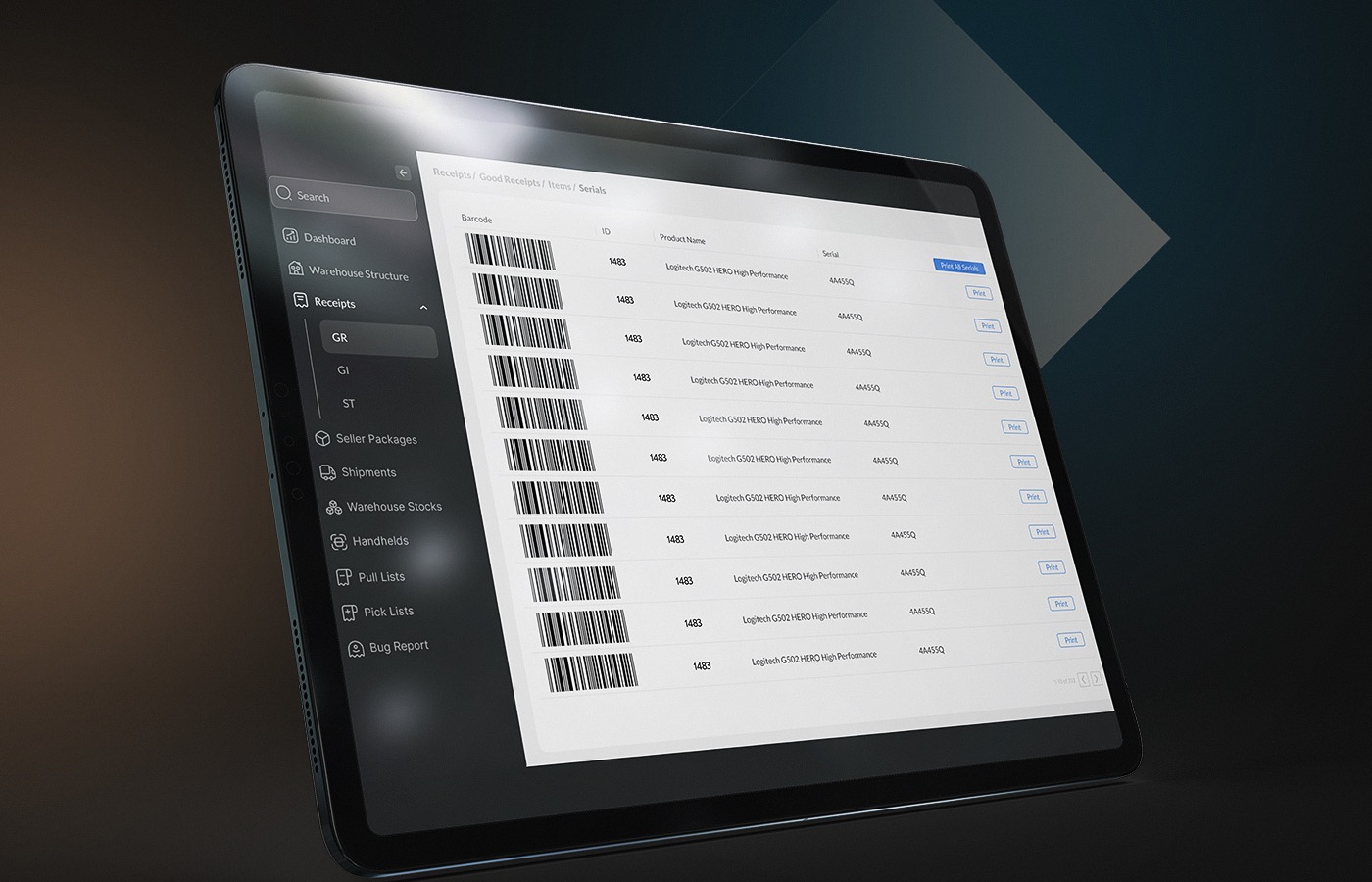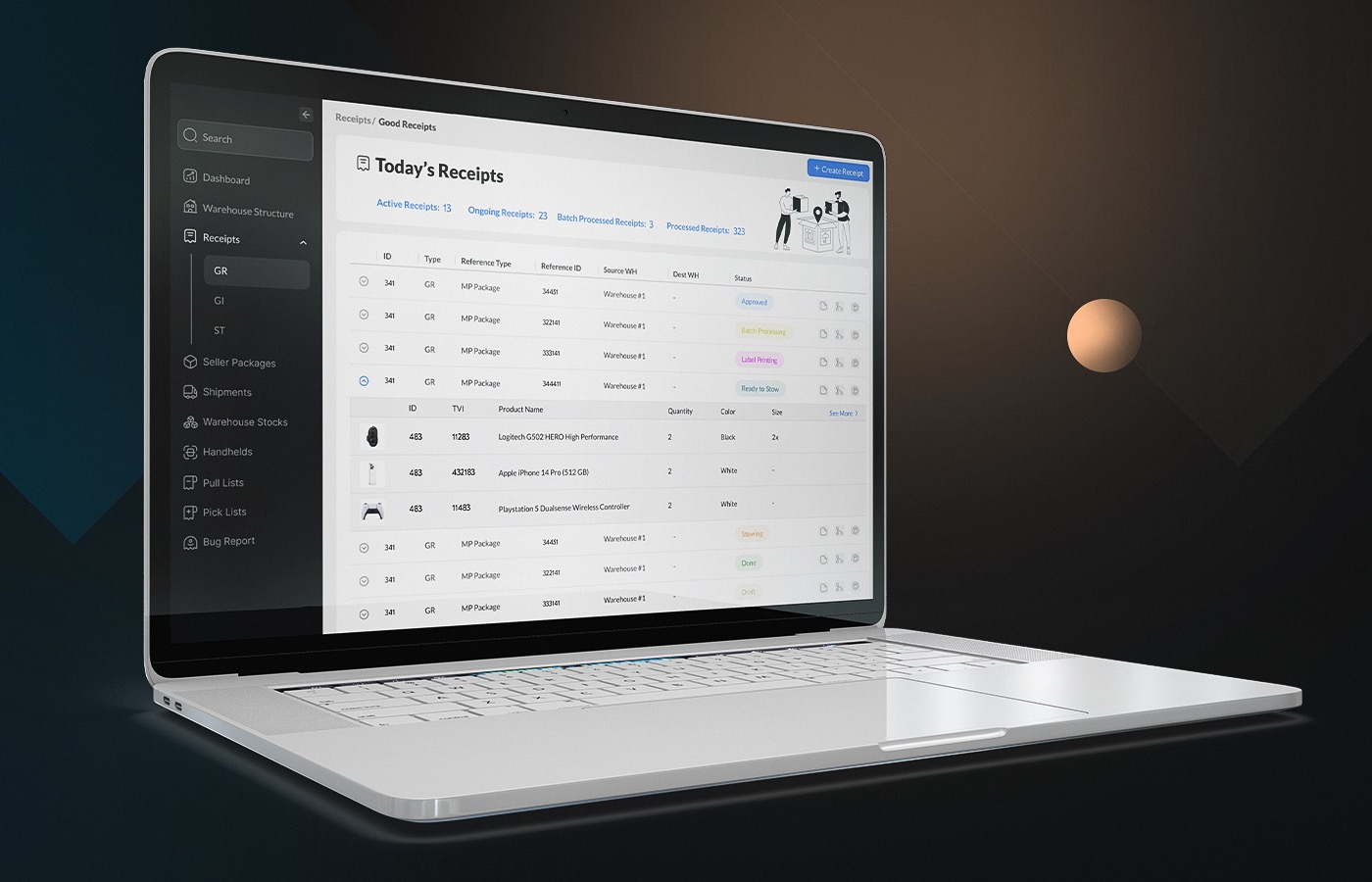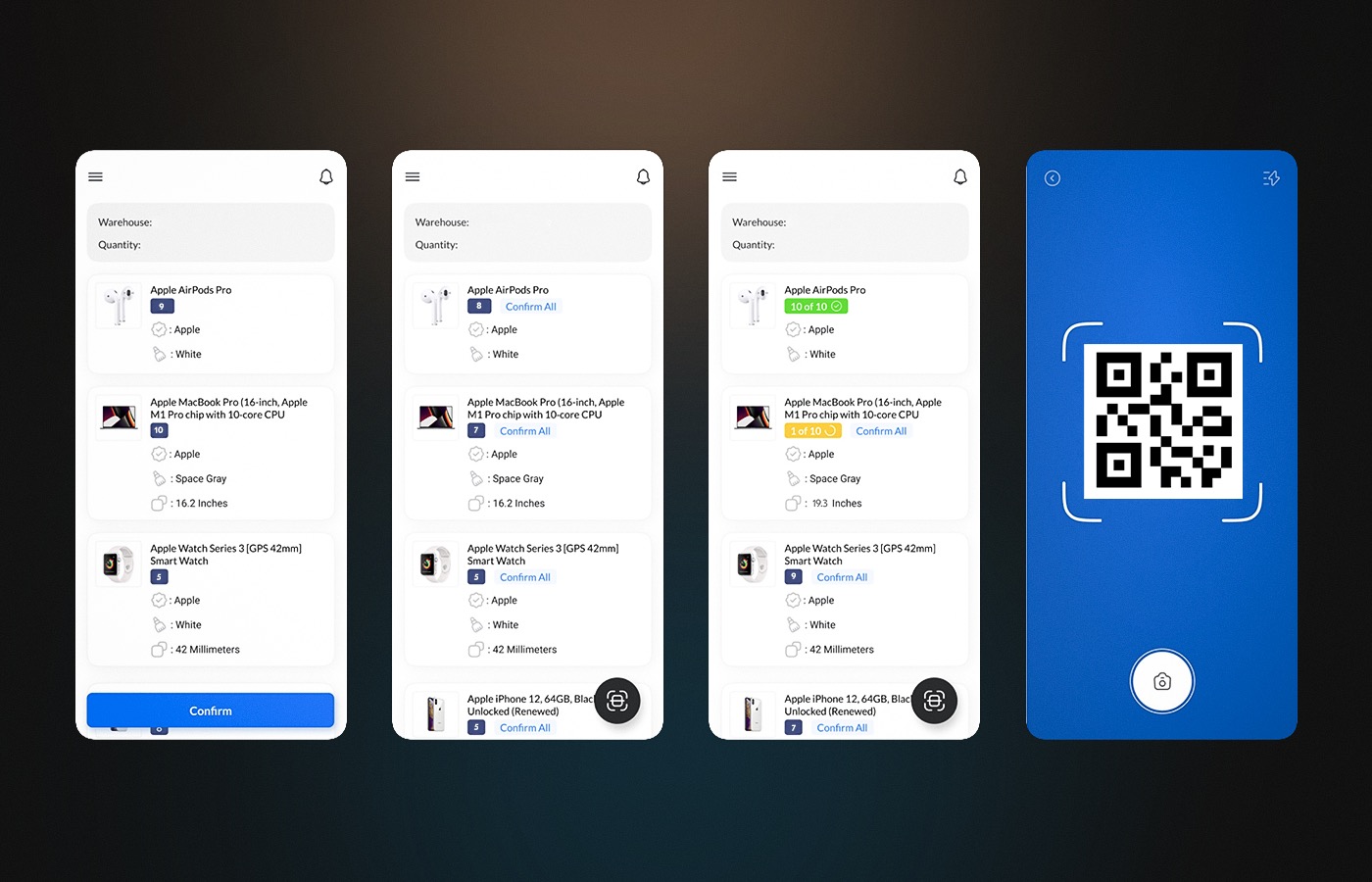

- SaaS
- Platform Development
- Software Development
- Bespoke software
- Custom Software Development
- Legacy System Modernization
- Automation
- Cloud Solutions
Building a comprehensive SaaS warehouse management system with advanced cloud based WMS capabilities and scalable infrastructure. Developing warehouse management software with complete inventory visibility, barcode and RFID scanning, wave picking and batch picking, cross docking and cycle counting, real time tracking, ERP and TMS integration, mobile scanners support, multi tenant architecture, role based access control, guaranteed uptime sla and audit logs for 3PL warehouse management operations.
client
NDA Protected
USA
200-500 employees
Our client is a leading third-party logistics provider operating multiple warehouses across the United States. They manage inventory for a diverse range of clients, including e-commerce retailers, manufacturers, and distributors. The company manages millions of SKUs each month, with intricate order fulfillment needs.. Their operations span temperature-controlled facilities, hazardous materials storage, and standard warehousing.
They generated a reputation around accuracy and speed among Fortune 500 companies. The firm needed modern 3PL warehouse management technology replacing legacy systems and supporting continued growth across new facilities and client segments.
request background
SaaS Warehouse Management System Development for Modern Logistics Operations
The company operated with outdated warehouse management system limiting growth potential. Legacy systems lacked proper inventory visibility across facilities. Manual processes dominated operations, creating inefficiencies and errors. The absence of modern cloud-based WMS prevented real-time collaboration between warehouses.
Management recognized needing comprehensive SaaS warehouse management system supporting their 3PL warehouse control business model. The solution required serving multiple clients on single platform through multi tenant architecture. Each client needed isolated data and customized workflows. Role based access control would manage permissions across different user types.
Operations demanded complete inventory visibility from receiving through shipping. Barcode and RFID scanning would eliminate manual data entry. The warehouse management software needed supporting wave picking and batch picking strategies optimizing labor. Cross docking and cycle counting capabilities would improve accuracy and throughput.
Real time tracking was essential for customer transparency. Clients wanted monitoring their inventory movements instantly. The SaaS warehouse management system required ERP and TMS integration connecting with existing business systems. Mobile scanners would enable warehouse staff working efficiently throughout facilities.
Reliability was critical. The cloud-based WMS needed guaranteed uptime sla ensuring continuous operations. Comprehensive audit logs would track all system activities for compliance and troubleshooting. The 3PL warehouse management platform had to scale supporting new warehouses and growing transaction volumes without performance degradation.
challenge
Complex Requirements for Multi-Tenant 3PL Warehouse Management System
Legacy system limitations. Existing warehouse management software couldn't support modern operations. There was no visibility into inventory across all their warehouses. Mistakes and delays were being created by manual manipulation. There was no way to integrate with ERP and TMS systems. The platform couldn't support 3PL warehouse control requirements serving multiple clients.
Data isolation requirements. Building multi tenant architecture presented significant challenges. Each client in the SaaS warehouse management system needed complete data separation. Security concerns demanded preventing any data leakage between tenants. Role based access control had to work across complex organizational hierarchies. Performance couldn't degrade as tenant numbers increased.
Operational complexity. The cloud based WMS needed supporting diverse fulfillment strategies. Wave picking and batch picking required sophisticated algorithms. Cross docking operations demanded precise timing and coordination. Cycle counting had to occur without disrupting regular operations. Barcode and RFID scanning needed working with various hardware vendors.
Integration challenges. The warehouse management software required connecting with numerous external systems. ERP and TMS integration involved different protocols and data formats. Mobile scanners from various manufacturers needed seamless connectivity. Real time tracking demanded constant data synchronization. API design had to support current and future integration needs.
Reliability requirements. The 3PL warehouse control business couldn't tolerate downtime. The SaaS warehouse management system needed guaranteed uptime sla of 99.9%. Audit logs had to capture all activities for compliance. Backup and disaster recovery procedures were mandatory. Performance monitoring needed identifying issues proactively.
Scalability concerns. Supporting growing operations required careful architecture. The cloud based WMS had to handle increasing transaction volumes. New warehouses needed onboarding quickly without disrupting existing operations. The multi tenant architecture had to support hundreds of clients efficiently. Resource allocation needed optimizing costs while maintaining performance.
Mobile workforce needs. Warehouse staff worked throughout large facilities using mobile scanners. The warehouse management software interface had to work on various devices. Barcode and RFID scanning required millisecond response times. Real time tracking updates needed synchronizing across all users. Offline capabilities were essential for areas with poor connectivity.
goals
- Build scalable SaaS warehouse management system with robust multi tenant architecture supporting hundreds of 3PL warehouse control clients. Implement secure data isolation and role based access control ensuring complete tenant separation. Enable custom workflows and configurations for each client without code changes.
- Deploy comprehensive inventory visibility providing real time tracking across all warehouse locations and operations. Implement barcode and RFID scanning supporting diverse hardware vendors and label formats. Enable mobile scanners empowering warehouse staff with instant access to inventory data throughout facilities.
- Optimize fulfillment operations through advanced wave picking and batch picking algorithms. Implement efficient cross docking and cycle counting procedures improving accuracy and throughput. Build intelligent task management distributing work optimally across warehouse staff.
- Establish seamless ERP and TMS integration connecting the cloud-based WMS with existing business systems. Build flexible API framework supporting various integration patterns and data formats. Enable real time data synchronization maintaining accuracy across all connected platforms.
- Guarantee enterprise uptime sla and comprehensive monitoring to assure reliability. Roll out elaborate audit logs to trace all activities of the system for compliance and troubleshooting. Implement redundant systems and disaster recovery processes to avoid interruptions of operations.
- Create an intuitive user experience for warehouse management software supporting diverse user roles. Design responsive interfaces working across desktop and mobile devices. Build customizable dashboards providing relevant metrics and insights for different stakeholders in the 3PL warehouse control ecosystem.
solution
Cloud WMS That's Multi-Tenant and Packed with Advanced Fulfillment Capabilities
Vue.js, Python, Java, Django, RESTful APIs, RabbitMQ, AWS, Docker
Ongoing
7 specialists
We delivered comprehensive SaaS warehouse management system transforming 3PL warehouse control operations completely. The cloud based WMS combines scalability with advanced features supporting complex fulfillment requirements.
Multi-Tenant Platform. Built robust multi tenant architecture supporting complete data isolation between clients. The warehouse management software serves hundreds of tenants efficiently. Each client configures workflows, pick strategies, and user permissions independently. Role based access control manages permissions across complex organizational structures. Resource allocation optimizes costs while maintaining performance.
Inventory Management. Implemented complete inventory visibility across all warehouse locations. Real time tracking updates location, quantity, and status continuously. The SaaS warehouse management system supports lot tracking, serial numbers, and expiration dates. Cycle counting occurs without disrupting operations. Users monitor inventory movements from receiving through shipping instantly.
Scanning and Automation. Deployed comprehensive barcode and RFID scanning supporting various hardware vendors. Mobile scanners connect via WiFi and Bluetooth reliably. The cloud based WMS validates scans preventing errors. Batch operations process multiple items simultaneously. Automatic data capture eliminates manual entry reducing mistakes.
Fulfillment Optimization. Built sophisticated wave picking and batch picking algorithms optimizing labor efficiency. The warehouse management system groups orders intelligently minimizing travel time. Pick paths guide workers through optimal routes. Cross docking operations transfer goods directly from receiving to shipping. Task management distributes work balancing workforce utilization.
Integration Framework. Established seamless ERP and TMS integration through flexible APIs. The SaaS warehouse management system synchronizes orders, inventory, and shipments automatically. Real time data exchange maintains accuracy across platforms. Webhook notifications inform external systems of important events. Standard connectors support popular business applications.
Reliability and Security. Data center infrastructure to guarantee uptime SLAs of 99.9%. For a load balancer it spreads the traffic to many servers. Automatic failover protects against outages. Detailed audit trails log all executed actions including user information. Data is stored and transmitted in encrypted format. Regular backups enable disaster recovery.
- Tenant Isolation. The multi tenant architecture uses database-level separation with isolated schemas. Role based access control enforces permissions while the cloud based WMS scales resources independently.
- Mobile Platform. Built native applications for mobile scanners supporting barcode and RFID scanning. Offline mode enables work during connectivity issues with automatic synchronization.
- Pick Optimization. Implemented wave picking and batch picking algorithms grouping orders intelligently. The SaaS warehouse management system places fast-moving items optimally with verification steps ensuring accuracy.
- Cross Docking and Counting. Built cross docking workflows matching inbound shipments with outbound orders automatically. Cycle counting schedules based on velocity while real time tracking updates inventory without disrupting operations.
- Integration Architecture. Designed flexible API framework supporting ERP and TMS integration with RESTful endpoints. The cloud based WMS includes comprehensive API documentation and webhook notifications.
- Monitoring and Logging. Deployed monitoring tracking uptime sla compliance with detailed audit logs capturing all activities. Automated alerts notify administrators of issues proactively.
- Inventory Visibility. Created dashboards providing complete inventory visibility across warehouses. The warehouse management system displays real-time movements with automated alerts for stakeholders.
outcome
Cloud-Based WMS Delivering Efficiency Improvement and 99.9% Uptime
- 40% increase in fulfillment efficiency. Wave picking and batch picking optimization reduced labor costs significantly. Cross docking operations improved throughput. The SaaS warehouse management system automated manual processes. Mobile scanners eliminated paper-based workflows. Pick accuracy improved from 95% to 99.7%.
- 99.9% uptime achievement. The cloud based WMS exceeded guaranteed uptime sla targets. Zero unplanned outages occurred during operations. Automatic failover protected against infrastructure issues. System performance remained consistent during peak volumes. The 3PL warehouse management platform proved enterprise reliability.
- Complete inventory visibility. Real time tracking provided instant access to inventory status. Cycle counting reduced discrepancies by 85%. Barcode and RFID scanning eliminated manual errors. Clients accessed their inventory data through secure portals. The warehouse management software improved inventory accuracy from 92% to 99.5%.
- 50+ client onboarding. The multi tenant architecture supported rapid 3PL warehouse management growth. New clients onboarded in days rather than months. Role based access control simplified permission management. Each tenant configured workflows independently. The SaaS warehouse management system scaled efficiently with growing client base.
Related cases
Articles you may also like
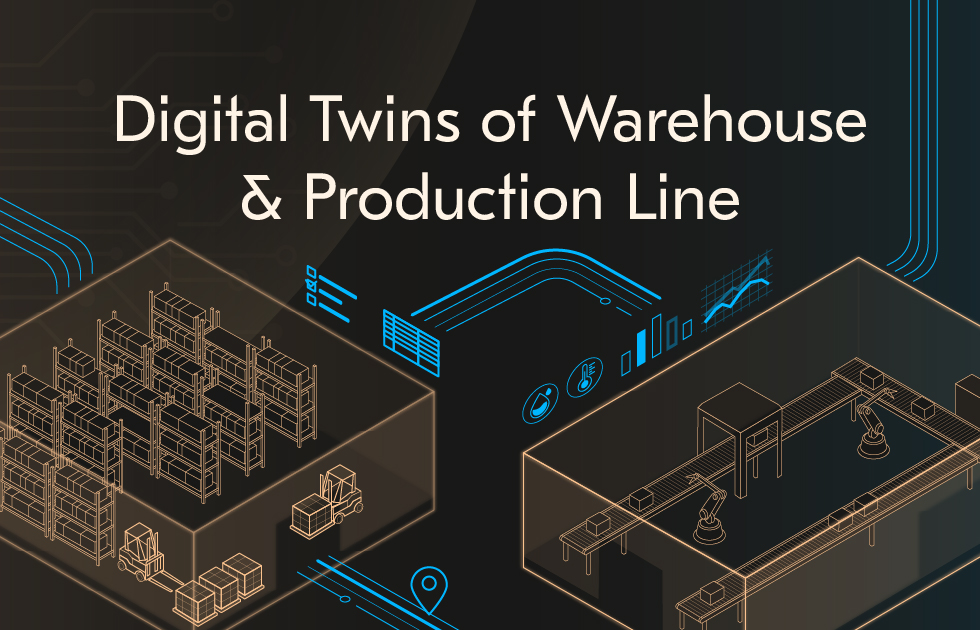
Digital twins of the warehouse and production line: modeling, telemetry and payback KPIs
![AI in Warehouse Management: [Benefits & Use Cases]](/img/articles/ai-in-warehouse-management/img01.jpg)
Why & How to Employ AI in Warehouse Management: Applications & Success Cases
![IoT for Supply Chain Businesses: [6 Use Cases Included]](/img/articles/iot-for-supply-chain-management/img01.jpg)
IoT for Supply Chain Management: Use Cases, Benefits & Real Examples
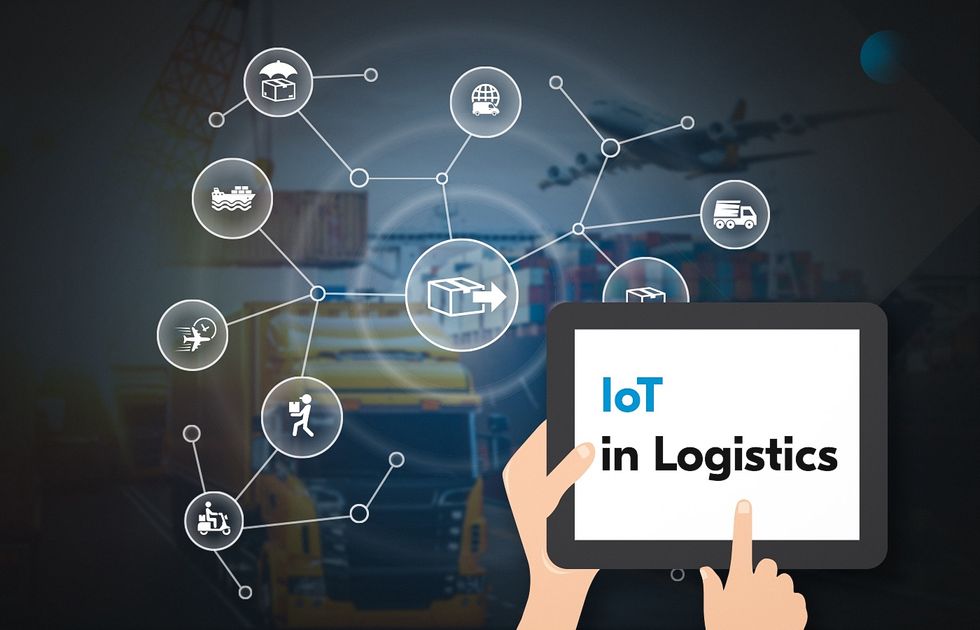
Embracing IoT in Transportation and Logistics to Boost Supply Chain Visibility
![ᐉ Airport Operations Management Solftware [2025 Guide]](/img/articles/airport-operations-management/img01.jpg)
Airport Operations Management Software to Modernize Your Business in 2025
![ᐉ Big Data in Logistics: Key Benefits [5 Real Use Cases]](/img/articles/big-data-in-logistics/img01.jpg)
Big Data in Logistics: Key Benefits & 5 Real Use Cases
![AI Route Planning in 2025: [Use Cases & Benefits]](/img/articles/ai-route-planning/img01.jpg)
AI Route Planning: Must-Have Automation & Optimization Practices in 2025
![ᐉ Mapbox vs. Google Maps [Choosing a Map API]](/img/articles/map-api/img01.jpg)
Mapbox vs. Google Maps: Choosing a Map API
![Machine Learning in Logistics and Supply Chain [7 Use Cases Included]](/img/articles/machine-learning-in-supply-chain-and-logistics/img01.jpg)
Adopting Machine Learning in Supply Chain and Logistics for Successful Automation
![Transport App Development [A 2025 Guide for Startups & Businesses]](/img/articles/transportation-app-development-guide/img01.jpg)
Transportation App Development Guide for Businesses: Benefits, Features & Case Studies
![ᐉ Blockchain in Logistics [Key Benefits & Real-Life Use Cases]](/img/articles/blockchain-implementation-in-logistics/img01.jpg)
Blockchain in Logistics: Key Benefits & Real-Life Use Cases
![Blockchain for Supply Chain Management: [Benefits & Use Cases]](/img/articles/why-and-how-to-employ-blockchain-in-supply-chain-management-tips-and-success-stories/img01.jpg)
Why and How to Employ Blockchain in Supply Chain Management (Tips & Success Stories)
![Generative AI in Supply Chain Management: [Use Cases & Solutions]](/img/articles/generative-ai-supply-chain-solutions/img01.jpg)
Investing in Generative AI Supply Chain Solutions: Use Cases & Challenges for 2025
![Predictive Analytics for Supply Chains in 2025: [Benefits & Applications]](/img/articles/predictive-analytics-in-supply-chains/img01.jpg)
Why Use Predictive Analytics in Supply Chains? Advantages, Use Cases & Solutions

Top Logistics Technology Trends Reshaping the Industry in 2025
![Fleet Fuel Management System [Complete Guide]](/img/articles/build-a-fuel-management-system/img01.jpg)
How to Build a Fleet Fuel Management System [Complete Guide]
![A Sustainability Transportation Guide: [Best Practices & Use Cases]](/img/articles/sustainable-transportation-practices/img01.jpg)
Sustainable Transportation Practices: Why Invest in Renewable Energy in 2025
![ᐉ Logistics Customer Portal Development: [2025 Guide]](/img/articles/logistics-customer-portal-development/img01.jpg)
Logistics Customer Portal Development: Step-by-Step Guide
![Transportation Telematics System: [Benefits, Challenges & Use Cases]](/img/articles/the-power-of-telematic-systems-in-transportation-benefits-challenges-and-use-cases/img01.jpg)
The Power of Telematic Systems in Transportation: Benefits, Challenges & Use Cases
![ᐉ Uber API Integration: [Step-by-Step Guide & Use Cases]](/img/articles/how-to-integrate-uber-api/img01.jpg)
Uber API Integration: A Complete Guide with 7 Benefits & Examples
![Big Data in Supply Chain: [9 Real Use Cases Included]](/img/articles/big-data-in-supply-chain-real-world-use-cases-and-success-stories/img01.jpg)
Big Data in Supply Chain: Real-World Use Cases and Success Stories
![6 Use Cases of AI in Transportation and Logistics: [2025 Edition]](/img/articles/ai-in-transportation/img01.jpg)
Use Cases of AI in Transportation & Logistics: Are They Relevant for Your Business?
![IoT in Fleet Management: [Use Cases, Trends & Case Studies]](/img/articles/employing-iot-for-fleet-management-benefits-use-cases-and-success-stories/img01.jpg)
Employing IoT for Fleet Management: Benefits, Use Cases & Success Stories
![Last-Mile Delivery Optimization: [Key Strategies in 2025]](/img/articles/last-mile-delivery-solutions-optimize-logistics-for-better-customer-satisfaction/img01.jpg)
Last-mile Delivery Solutions: Optimize Logistics for Better Customer Satisfaction
![Load Planning Software: [Features, Types and Benefits]](/img/articles/load-planning-software-features-types-and-benefits/img01.jpg)
Load Planning Software: Features, Types and Benefits
How to Develop a GPS Tracking Software for Real-time Vehicle Tracking
![Best Trucking Software in 2025: [Custom or Off-The-Shelf]](/img/articles/best-trucking-software-to-consider-custom-vs-off-the-shelf/img01.jpg)
Best Trucking Software to Consider in 2025: Custom vs Off-the-Shelf
![Multi-Carrier Shipping Software: [8 Use Cases & Key Benefits]](/img/articles/multi-carrier-shipping-software-a-guide-to-enhancing-shipping-efficiency/img01.jpg)
Multi-Carrier Shipping Software: a Guide to Enhancing Shipping Efficiency

How to Build Custom Fleet Management and Maintenance Software
![Transportation Management Software Development [2025 Guide]](/img/articles/transportation-software/img01.jpg)
Transportation Management Software Development — A Detailed Overview
![How to choose the Best Transportation Management Software [2025 Guide]](/img/articles/best-transportation-management-software/img01.jpg)
How to Choose the Best Transportation Management Software: Custom vs. Off-the-Shelf
![Warehouse Automation Systems [8 Benefits for Your Business]](/img/articles/warehouse-automation-systems/img01.jpeg)
Warehouse Automation Systems: Technologies Taking Warehousing to the Next Level

How to develop a logistics document management system (case study included)

3PL Warehouse Management System: Why Choose a Custom SaaS WMS for Your Warehouse
![Supply Chain Analytics Software [Key Features & Use Cases]](/img/articles/supply-chain-analytics-software/img01.jpg)
Employing Supply Chain Analytics Software for Efficient Workflows — Key Features & Use Cases
![The Best Route Optimization Software to Employ in [2025]](/img/articles/route-optimization-software/img01.jpg)
Custom vs. Off-the-Shelf Route Optimization Software: Which Serves You Best?
![Logistics & Shipping APIs Integration Guide [2025]](/img/articles/logistics-and-shipping-apis/img01.jpg)
A Guide to Integrating Logistics and Shipping APIs to Optimize Your Supply Chain Business
![Best Truck Dispatching Software to Consider in [2025]](/img/articles/best-trucking-dispatching-software/img01.jpg)
Best Trucking Dispatching Software in 2025: Custom vs Off-the-Shelf
![Cloud Computing in Logistics and Supply Chain [2025 Guide]](/img/articles/cloud-computing-in-logistics-and-supply-chain/img01.jpg)
Cloud Computing in Logistics and Supply Chain: Use Cases Included
![ᐉ Warehouse Management Systems Development [2025 Guide]](/img/articles/warehouse-management-systems/img01.jpg)
Warehouse Management Systems Development: Empowering Real-Time Tracking and Visibility

Chatbots in Logistics & Transportation: Benefits & Use Cases

Logistics & Transportation Software Modernization: Best Practices and Lessons Learned

How Software for Freight Brokers Increases Business Efficiency and Profitability: Real-World Examples

Logistics App Development: Building a Product That Will Help Your Business
![Logistics Management System [2025 Guide]: Use Cases Included](/img/articles/logistics-management-system/img01.jpg)
Why A Logistics Management System Is A Must For Successful Supply Chain Operations

Supply Chain Management Software System: Its Features, Benefits, and How to Integrate a Suitable One

How to Turn Custom Freight Forwarding Software to Your Advantage
![Shipping Management System Development ☑️ [2025 Guide]](/img/articles/shipping-management-system/img01.jpg)
How to Automate the Shipping Process with a Shipping Management System

Guide of How to Integrate e-AWB for a Freight Forwarder

Why It Pays to Build Dispatch Management Software

How to Build Vehicle Routing Software to Earn More and Drive Less?

EDI in Logistics: How to Develop EDI Software to Make an E-Switch?


